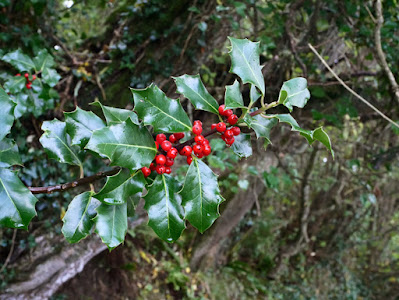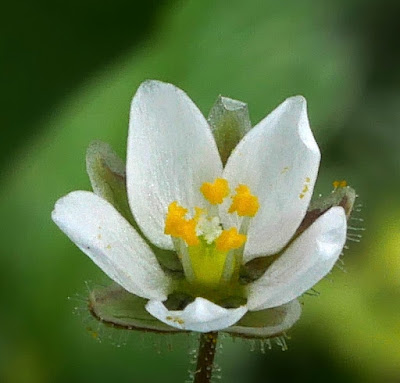I started the month with a trip to the south coast recording in the south western corner of St Austell Bay. There were plenty of plants still to see even though Summer had now passed in to Autumn.
This is Common Ramping Fumitory, the commonest Fumitory in Cornwall, but one has to take care it isn't one of the other larger species like Western Ramping or White Ramping Fumitories. The size and colour of the flowers, flower tips and the shape and size of the sepals are needed to key these out.
Fumaria muralis
In
a coastal woodland was a carpet of yellow flowered strawberry plants, a
frequent garden escape, but that that widespread overall. The fruit is
supposedly insipid, but I refrained from eating any.
Potentilla indica
On
an exposed cliff facing the sea were several colonies of Haresfoot
Clover which has an attractive fluffy looking flowerhead made up of
numerous individual white flowers.
Trifolium arvense
As
I walked down the coastal path to a place called The Vans, which is
rather an odd name, I came across several Mulleins along it. Careful
examination of the flowers revealed this to be Dark Mullein and it had
previously been recorded here before too. Note the all purple hairs on
the stamens.
Verbascum nigrum
A few days later I was walking locally near St. Breock and found a patch of "waste ground" which was botanically rich in species. One species was this Bugloss below, with its tiny but bright blue flowers.
Anchusa arvensis
Nearby were several flowering crucifers. The bright green foliage and upper stem leaf shape showed it to be Common Wintercress. I usually only find this in flower in the Spring.
Barbarea vulgaris
I then explored a nearby churchyard and along its edges, paths and outside it were clumps of Common Calamint which I find is an attractive but not large flowered member of the Mint family.
Clinopodium ascendens
Michaelmas
Daisies are quite common but there are several different types and they
can be tricky to identify. I have included some notes on the photo
below to show you some of what is needed to identify them. Very obvious
on this specimen was that the phyllaries were quite a bit wider above
their middle and easy to see too.
Most St. John's Wort have gone to seed now, but I found this late straggler still flowering. It has square stems which narrowed it down to Square Stalked or Imperforate. However, as the leaves had lots of white glands (hold one up to the light to see them), it could only be Square-stalked St. John's wort. It's flowers are smaller and usually more numerous than other Hypericums and the upright slightly bushy look of the plant is immediately recognisable anyway.
Hypericum tetrapterum
On a country lane I found these three plants growing out of a wall that I did not recognise at first. These are Giant Viper's Bugloss, a plant I want for my own garden as bees love them. You can see the parent plant within the garden behind the gate.
Echium pininana
At
the freshwater end of a saltmarsh creek, I found my first colony of
Apple Mint. At first, I thought it was Spearmint, given the
inflorescences, but the leaves were wrong. The leaves did not smell very
nice when crushed either, unlike Spearmint leaves.
Mentha x villosa
Back to my local area and on a walk along the tidal River Camel I found these Snapdragons growing wild on a disused industrial plot.
Antirrhinum majus
Stinking Iris were in full seed now and as the pods split, they reveal their lovely coloured seeds.
Iris foetidissima
Common
Cord Grass was flowering along the mudflats, enhanced by the array of
colours from aging Glassworts (there will be a seperate blog on
Glassworts soon).
Spartina anglica
Near
the high tide mark, but below it, I found this striking Atriplex or
Orache. I have quite got into these and have found several hybrids. The
BSBI referee identified this as the hybrid between Spear-leaved and
Babbington's Orache. One needs to look very closely at the bracteoles,
seeds and leaves to try and work these species out. A useful tip is to
look at BSBI News and plant cribs for Atriplex which hold a wealth of
information to help one identify which species has been found.
The Camel Trail is well worth walking as well as cycling, though I wish the cyclists would be a bit more considerate to pedestrians and slow down as they approach them. On a wall there, I found a colony of Sea Spleenwort, an unusual, fleshy fern only found by the sea.
Asplenium marinum
In the grasses were some sedges. These were Long-bracted Sedge as evidenced by the very long bracts surpassing the seedheads.
Carex extensa
The other out of season flower was this lovely Burnet Rose, a rare plant back in Kent, but relatively common along the cornwall coasts.
Rosa spinosissima
Social media has been full of out of season plants in flower, so it was nice for me to find some too. I suspect the drought breaking recently triggered stressed plants in flowering again before the frosts arrive.
The most common Sea-Spurrey that I find is usually Rock Sea-Spurrey, so it was nice to find some Greater and Lesser Sea-Spurries along Little Petherick Creek shores. The plant below is Greater Sea-Spurrey that has 10 stamens and the petals are longer than the sepals. Lesser, has around 7 stamens and tiny flowers that do not exceed the sepals.
Spergularia media
Of
course, now it's Autumn and the soil is damp, the fungi are appearing.
This, I believe, is Honey Fungus, attractive, but one that would be
unwelcome in gardens.
Spindle is a small to medium native tree with leaves and flowers that are non-descript. The time to see it is now, when the brightly coloured pink seed capsules are present. These split to expose orange seeds within.
Euonymus europaeus
Henbit
Dead-Nettle on the same grassy verge as the Musk Storksbill. Nicknamed
"Happy Giraffes" by a botanist on social media! I can see why.
Lamium amplexicaule
I don't usually see Hedge Woundwort at the top of the beach, but it seems that in Cornwall, anything goes!
Stachys sylvatica
As if to contrast with the occasional Spring flower seen, the Holly was looking decidedly festive.
Ilex aquifolium
I
also found Tashereau's Orache in two locations, but it is a dull plant
and not very photogenic at this time of the year. Identity again
confirmed by the Atriplex referee, it was the hybrid between
Long-stalked and Babbington's Oraches. The seed is slightly out of
focus, but then they are tiny!
Atriplex glabruiscula x longipes = A, x taschereaui
For much of October I was visiting estuaries and saltmarshes looking for new Glasswort records. I did find some, though there aren't many species in Cornwall compared to other regions. They will feature in my next blog, but this one rounds off my general finds for October in Cornwall. I hope you enjoyed it.
Regards
Dave



























































